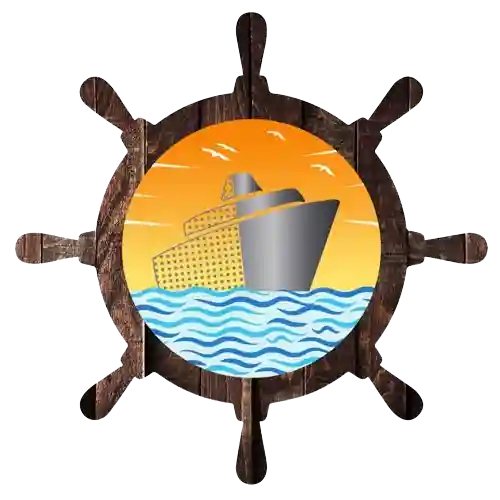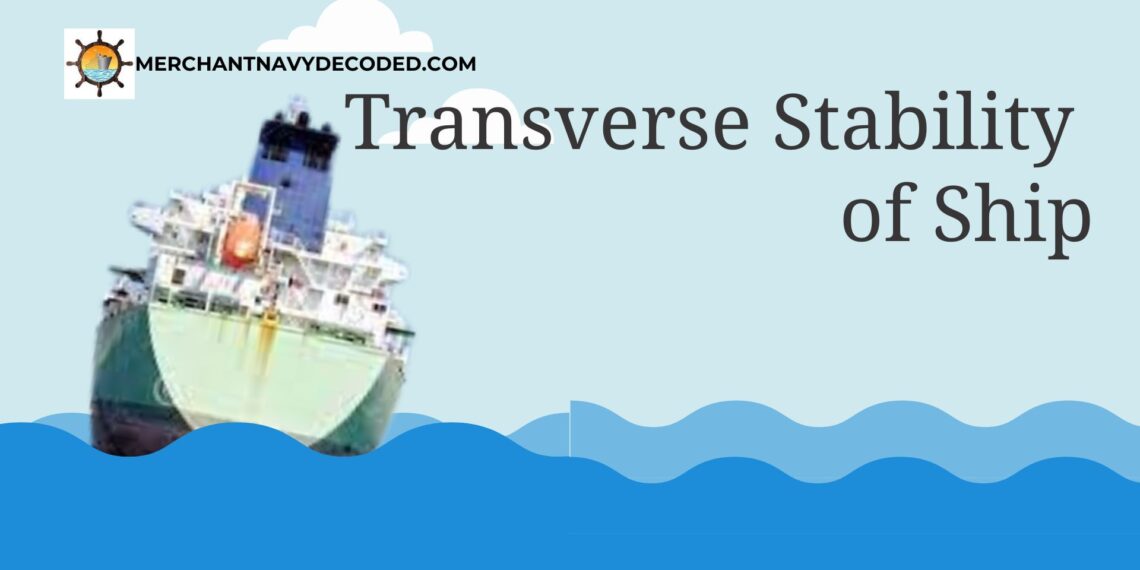Transverse Stability of Ship
Table of contents
1. Basic Understanding of Transverse Stability
The transverse stability of a ship refers to a ship’s capacity to stay balanced despite being tilted to one side. The healing can happen due to the action of the force of wind, swell, etc. It is always necessary to maintain static stability even when the ship has altered the distribution of weights.

2. Difference between List and Heel
2.1:- Listing of Ship
The list is the sideways tilt resulting from an imbalance in weight distribution on either side of the ship’s centerline. In other words, the list is caused when the centre of gravity of the ship is not on the centre line due to internal causes. A vessel tilting to one side will regain its upright position only when the centre of gravity is returned to the centre line.
2.2:- Heel of Ship
The heel is the transverse inclination of the ship caused by external forces such as wind, waves, centrifugal force during course alterations, over-tight mooring in port, etc. Since no transverse weight shift has taken place on board, the position of the COG of the ship remains unaffected by the heel.
When a ship is heeled over to one side, say to starboard, her underwater volume increases on the starboard side and decreases on the port side.

Where B = is the COB before heeling.
B1 = is the COB after heeling.
B to B1 = is the shift of COB caused by heeling.
3. Transverse Metacentre
When a ship is tilted due to external forces, the buoyant force, which acts vertically upward through the new location of the centre of buoyancy (COB), intersects the ship’s centerline at a specific point known as the transverse metacentre (M). The height of M above the keel, measured in meters (KM), indicates its position.
Over small angles of the heel (say up to about 15 degrees) the increase of KM is generally small. Hence, KM is considered constant for small angles of the heel.

4. Metacentric height (GM)
It is the vertical distance between the COG and the metacentre. Metacentric height is said to be positive when G is below M i.e., when KG is less than KM and GM is said to be negative when G is above M i.e., when KG is greater than KM.
Over small angles of the heel, wherein KM may be considered constant, GM also is considered constant and is referred to as initial GM.
5. Righting Lever (GZ)
When a vessel is heeled (inclined by an external force), the force of buoyancy, which is acting vertically upwards through the new position of COB, becomes separated from the force of gravity, acting vertically downwards through the COG, by a horizontal distance called righting lever (GZ).
GZ normally increases as the angle of the heel increases until it reaches a maximum value at some large angle of the heel.
For small angles of the heel (less than 15 degrees), herein KM and hence GM, may be considered constant,
GZ = GM. Sinθ ( θ is the angle of heel)
For large angles of the heel, GZ can be calculated by the wall-sided formula
GZ = Sinθ (GM + ½ (BM TAN^2 θ))

6. Righting Moment
When a vessel is heeled (inclined by an external force), the forces of gravity and buoyancy, being equal and opposite, become separated by a horizontal distance called the righting lever and form a couple which tries to return the vessel to upright.
The moment of this couple is a measure of the tendency of the vessel to return to upright and is hence called the righting moment or ‘Moment of static stability’
RM = W.GZ for all angles of the heel
For small angles of the heel, where GM may be considered constant
GZ = GM.Sinθ
7. Equilibrium of Ship
7.1:- Stable Equilibrium
When a vessel is heeled ( inclined by an external force ), if she tends to come back to her original condition, she is said to be in stable equilibrium.
For a vessel to be stable, her GM must be positive i.e., KG must be less than KM.

7.2:- Unstable Equilibrium
When a vessel is heeled (inclined by an external force), if she tends to continue healing further, she is said to be in unstable equilibrium.
To consider a ship unstable, its metacentric height (GM) must be negative, signifying that KG exceeds KM.

7.3:- Neutral Equilibrium
When a vessel is heeled (inclined by an external force), she does not tend to return to her original condition or to continue healing further, she is said to be in neutral equilibrium.
For a vessel to be in neutral equilibrium, her GM must be zero i.e., KG equals KM.

For more information like this check our blogs on Reserve Buoyancy.
Conclusion
In conclusion, a thorough understanding of the transverse stability of the ship is paramount for ensuring the safety and stability of ships at sea. From grasping the fundamental concepts of transverse stability to discerning the nuances between list and heel, and comprehending critical factors like metacentric height and equilibrium, this knowledge forms the bedrock of maritime operations.
By mastering the principles outlined in this discourse, maritime professionals can navigate challenges with confidence, ensuring vessels remain steadfast even amidst turbulent waters. Thus, embracing the principles of transverse stability of the ship is not merely a necessity but a cornerstone for safeguarding lives, cargo, and the integrity of maritime endeavours.
If you’re seeking guidance on applying for Advanced Dangerous Cargo Endorsement (DCE), Click here!
Frequently Asked Questions
1:- What do you understand by transverse statical equilibrium?
- Transverse statical stability is the ability of a vessel to remain upright when it has been heeled. The healing can happen due to the action of the force of wind, swell, etc.
2:- What is a metacentre?
- When a vessel has heeled the force of buoyancy, acting vertically upwards through the new position of COB, cuts the centreline of the ship at a point called the transverse metacenter (M).
3:- What is a metacentric height?
- It is the distance from the COG which is the center of gravity to the metacentric center.
4:- What is a righting lever?
- When a ship tilts, the upward force of buoyancy, at the new center of buoyancy (COB), creates a horizontal distance from the downward force of gravity, at the center of gravity (COG), known as the righting lever
5:- What are the 3 types of ship stability conditions?
- The three types of stability conditions on ships are positive, negative, and neutral stability.
6:- What is BM in ship stability?
- The metacentric radius BM is solely determined by the shape of the hull below the waterline
Disclaimer :- The opinions expressed in this article belong solely to the author and may not necessarily reflect those of Merchant Navy Decoded. We cannot guarantee the accuracy of the information provided and disclaim any responsibility for it. Data and visuals used are sourced from publicly available information and may not be authenticated by any regulatory body. Reviews and comments appearing on our blogs represent the opinions of individuals and do not necessarily reflect the views of Merchant Navy Decoded. We are not responsible for any loss or damage resulting from reliance on these reviews or comments.
Reproduction, copying, sharing, or use of the article or images in any form is strictly prohibited without prior permission from both the author and Merchant Navy Decoded.




Good
Very good explanation
Hi Kanu, glad you liked it. Let us know if you need any further guidance.
Yes